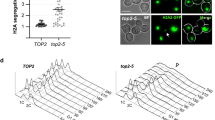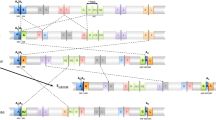Abstract
The giant polytene chromosomes of Drosophila melanogaster have long been of interest to the geneticist because of the visible map of the genome provided by their characteristic banding patterns1. An issue in the understanding of the molecular basis of chromosome banding has been whether the chromosomal DNA is replicated to the same extent in bands and interbands. Although various suggestions have been put forward the point has remained controversial2–5. We have isolated 315 kilobases (kb) of contiguous Drosophila genomic DNA6 which spans an interval of approximately 13 bands and interbands of the polytene chromosomes7. We report here the measurement of the relative level of DNA replication in polytene chromosomes of 84 adjacent restriction fragments of our cloned DNA. We conclude that there are no significant differences in the level of polyteny within the large band and between bands and interbands of this region. This result supports the ‘folded fibre’ model of polytene chromosome organization8, rather than models involving disproportionate replication along the banding pattern2–4.
This is a preview of subscription content, access via your institution
Access options
Subscribe to this journal
Receive 51 print issues and online access
$199.00 per year
only $3.90 per issue
Buy this article
- Purchase on Springer Link
- Instant access to full article PDF
Prices may be subject to local taxes which are calculated during checkout
Similar content being viewed by others
References
Painter, T. S. Genetics 19, 179–188 (1934).
Sorsa, V. Hereditas 78, 298–302 (1974).
Laird, C. D. Cell 22, 869–874 (1980).
Laird, C. D., Wilkinson, L., Johnson, D. & Sandström, C. Chromosomes Today Vol. 7 (eds Bennet, M., Bobrov, M. & Hewitt, G.) 74–83 (George, Allen & Unwin, Hemel Hempstead, 1981).
Beermann, W. (ed.) Results and Problems in Cell Differentiation Vol. 4, 1–33 (Springer, New York, 1972).
Bender, W., Spierer, P. & Hogness, D. S. J. molec. Biol. 168, 17–33 (1983).
Spierer, P., Spierer, A., Bender, W. & Hogness, D. S. J. molec. Biol. 168, 35–50 (1983).
DuPraw, E. J. & Rae, P. M. M. Nature 212, 598–600 (1966).
Lis, J. T., Prestidge, L. & Hogness, D. S. Cell 14, 901–919 (1978).
Endow, S. A. & Glover, D. M. Cell 17, 597–605 (1979).
Lyfschitz, E. J. molec. Biol. 164, 17–34 (1983).
Bender, W. et al. Science 221, 23–29 (1983).
Hilliker, A. J., Clark, S. H., Chovnick, A. & Gelbart, W. M. Genetics 95, 95–110 (1980).
Author information
Authors and Affiliations
Rights and permissions
About this article
Cite this article
Spierer, A., Spierer, P. Similar level of polyteny in bands and interbands of Drosophila giant chromosomes. Nature 307, 176–178 (1984). https://doi.org/10.1038/307176a0
Received:
Accepted:
Issue Date:
DOI: https://doi.org/10.1038/307176a0
This article is cited by
-
Super-resolution microscopy reveals stochastic initiation of replication in Drosophila polytene chromosomes
Chromosome Research (2022)
-
Drosophila D1 overexpression induces ectopic pairing of polytene chromosomes and is deleterious to development
Chromosoma (2010)
-
Polytene chromosomes from ovarian pseudonurse cells of the Drosophila melanogaster otu mutant
Chromosoma (1994)
-
The faint band/interband region 28C2 to 28C4-5(−) of the Drosophila melanogaster salivary gland polytene chromosomes is rich in transcripts
Molecular and General Genetics MGG (1991)
-
Polytene chromosomes from ovarian pseudonurse cells of the Drosophila melanogaster otu mutant
Chromosoma (1989)
Comments
By submitting a comment you agree to abide by our Terms and Community Guidelines. If you find something abusive or that does not comply with our terms or guidelines please flag it as inappropriate.



